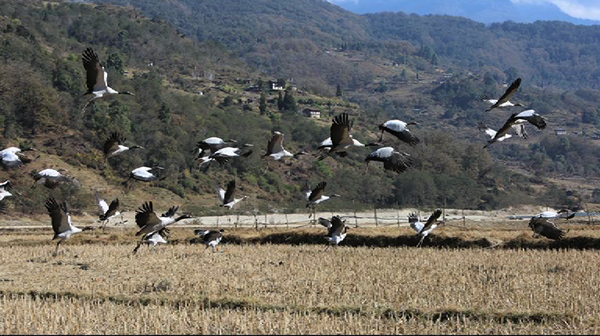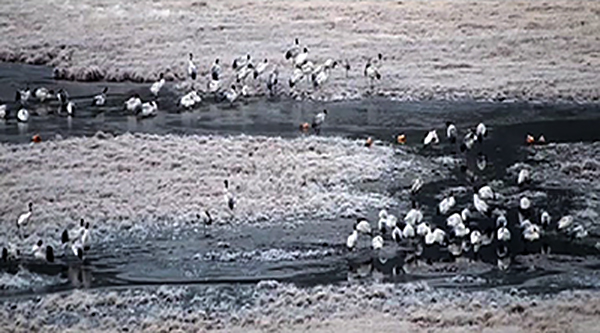 The Phobjikha valley, a popular winter roosting ground of the majestic black-necked cranes, has been seeing an increase in the number of the endangered birds over the years.
The Phobjikha valley, a popular winter roosting ground of the majestic black-necked cranes, has been seeing an increase in the number of the endangered birds over the years.
The valley hosted more than 500 cranes from October 2017 to February 2018. And close to 270 have arrived this year since October.
The Phobjikha Valley is also the largest protected wetland for the endangered bird.
The Royal Society for Protection of Nature (RSPN) has been carrying out numerous activities in the valley to secure both foraging and roosting habitats of the cranes.
The RSPN has worked in the valley for more than three decades now, says Jigme Tshering, the Deputy Chief Project Officer of the Crane Conservation Project.
Engaging with local communities to preserve the habitat remains at the heart of the crane conservation efforts by the RSPN’s Crane Conservation Project.
“We work with the local community there without undermining their livelihoods. It’s not like protect the habitat and forget the communities there,” Jigme Tshering said.
“The livelihoods of the community there also depend on the wetland. So, we work with the local community and then secure the habitats for the cranes.”
As a part of efforts to conserve the habitat of black necked cranes, the RSPN has initiated environmentally friendly alternative energy sources in the valley. More than 200 households in the valley are now lit with SPV solar home light.
RSPN also initiated eco-tourism for the benefit of the community.
 Other protected habitats see fewer cranes
Other protected habitats see fewer cranes
While Phobjikha valley has been witnessing increasing crane arrivals, the habitats in other parts of the country are seeing a decline.
The RSPN began keeping records of crane arrivals around mid-1980s. The Bumdeling valley in Trashi Yangtse used to see the highest number of cranes back then.
Conservationists attribute the decrease to the loss of habitat. Only 40 cranes arrived in Bumdeling so far this year.
“In Bumdelling, there has been both human pressure and natural factors, which led to the decrease in number of crane population,” Jigme Tshering said.
“From the anthropogenic pressure, it is mostly to do with the decreasing foraging sites mainly caused through the abandonment of paddy fields by the local people there due to human-wildlife conflict. From the natural angle, it has been due to the annual flashfloods washing away most part of the paddy fields, which are important foraging sites for the cranes,” he explained.
The roosting grounds in Bumthang and Lhuentse and Khotokha in Wangdue Phodrang have also been receiving fewer cranes. Only six cranes have arrived in Bumthang and seven in Khotokha so far this year.
“Habitats in central regions like Bumthang have also to do more with human pressure. There has been lots of development in Chamkhar,” Jigme Tshering said.
“People used to say hundreds of cranes used to visit before but now for obvious reasons only one or two are found.”
The loss of habitat is not the only threat to the vulnerable bird species. It also falls prey to wild and stray animals.
“There are lots of predators. In Phobjikha, we have been able to record the common leopards attacking the cranes through camera trappings. In other areas, it’s mostly stray dogs,” Jigme Tshering said.
“We have been working with our partners there-the department of livestock. They have been trying to control dog population. From the anthropogenic, it’s mostly encroachment into their habitat and also changes in the land use pattern by the farmers.”
The RSPN maintains and restores the cranes’ roosts every year around mid-September just before the bird’s arrival in the valley.
626 cranes arrived in the country’s wetlands in October 2017 to February 2018. It is the highest number ever.
With the birds still arriving, crane conservationists are expecting to see more arrivals this year.






